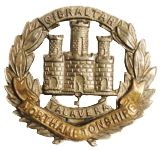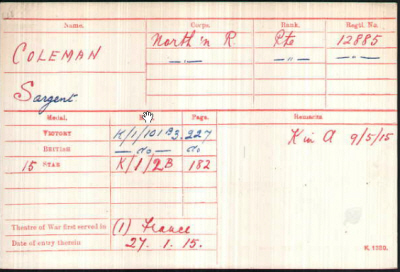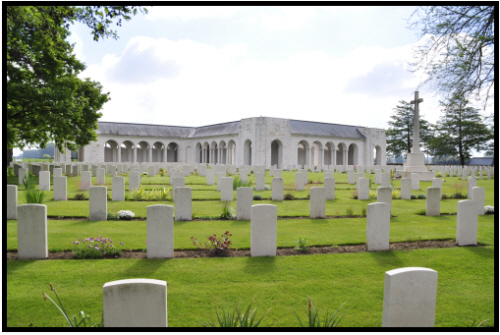



No. 12885, Private, Sargent COLEMAN
Aged 20

|
Born in Lakenheath, registered Mildenhall Q3-1894 [4A:753]. 1901 census...Aged 7, he was living at High Street, Lakenheath with his father- William Coleman [48] ex farm labourer, unemployed by virtue of being blind for 2 years, born Mildenhall; his mother - Emma (née BROWN) [47] born Lakenheath; sisters- Ruth [15]; Naomi [13]; Sarah [9] and Emma [5] all born in Lakenheath. 1911 census...Aged 16, a whip maker, he was living at Old Westwood Row, Westwood Street, Peterborough, with his widowed mother (charlady) and his sister Emma (whip maker). His father had died in 1903. It is recorded that his mother had been married 31 years ( more likely 39 from marriage register) and borne 13 children of whom 2 had died before 1911. |

|
He enlisted in Peterborough. thanks to http://1914-1918.invisionzone.com/forums/index.php?showtopic=161949, Stebie 9173 provided the war diary for that day....... War diary of the 1st Northamptons for the 9th May 1915: "Everyone was up at daybreak completing last details and arrangements. We had a large amount of stores to carry such as scaling ladders, bridges, wire cutters, bombs, flags for showing progress, etc. The morning was fine and very clear and the gunners observation officer attached for the day to the battalion thought it a perfect morning for the artillery. At 5.00 a.m. sharp the bombardment of the enemy lines and fortified posts commenced from our guns behind 18 pounders and 15 inch & 9.2 inch howitzers. The noise was terrific. This bombardment continued until 5.30 a.m. during which time the guns were playing on the various enemy batteries and fortified houses in the rear of the line. From 5.30 to 5.40 {artillery} fire was turned on to the enemy trenches which were sandbagged breastworks. The 18 pounder field guns played on the barbed wire entanglements and cut gaps for our infantry assault. During this 10 minutes the men of our leading companies B under Captain Dickson and D under Captain Farrar got over the parapet preceded by bombers, men carrying scaling ladders, etc. These companies advanced as close as possible to about 100 yards from the enemy parapet and there lay down until bombardment ceased. Again, at the same time two companies in the support trenches A and C under Captain Mylne and Captain Sir F Robinson, and battalion H.Q. moved from the supporting trenches to the fire trenches and thence over the parapet to support B and D. At 5.40 a.m. precisely the bombardment ceased and the battalion with the ROYAL SUSSEX rushed to the assault. Our first companies got close up to the German barbed wire and Captain Dickson and about 20 men reached a gap made by our guns in the trenches. There the men were all shot down, Captain Dickson being killed at once and also Captain Farrar. The enemy had opened a heavy rifle and machine gun fire from their trenches before our men could get near them and were mowed down. It was impossible to take the position and the assault had failed. Our artillery appeared to have done very little damage to the enemy as regards either parapet, wire or men themselves for even through the bombardment on their trenches rifle shots and machine gun fire was directed on our men as they came over our parapet. By this time the enemy had opened fire with his guns and heavily shelled our parapets, reserve trenches and RUE DU BOIS. The Battalion was now lying in front, between the two trenches, unable to advance or retire or even .. to move without being fired upon. Throughout the day the men lay out absolutely exposed to the rifle, machine gun and shell fire from the German lines. A few who were near our parapet managed to retire on the order being given. They were collected behind our lines and support trenches and there remained for the remainder of the day. At 3 p.m. another bombardment and assault was ordered, the 1st Brigade undertaking it this time, with no better results, though a few of the Black Watch got into the German trenches but were forced to retire. When darkness came the survivors crawled back to our trenches having lain out in the open for 14½ hours. The wounded, those that could be got to, were brought back, the Medical Officer, Lieutenant Bourdillon, doing very valuable work on this day. The commanding officer and adjutant brought out the remainder of the battalion (some 150 odd) to LE TOURET where orders were received to billet for the night, the 2nd Division having taken over trenches and operations from the 1st. Our losses were very heavy, 8 officers being killed & 9 wounded and 541 men killed, wounded or missing*. Of the 19 company officers that went out only 2 returned unhurt". * SDGW shows 262 killed with 1st Bn. on 9-5-1915. Only two officers are named though Of these 262, only 2 have known graves, the rest are all named on the Le Touret Memorial. A further 6 died the next day, presumably from their wounds. |
photo:Rodney Gibson

click here to go to the Commonwealth War Graves
Commission website for full cemetery/memorial details